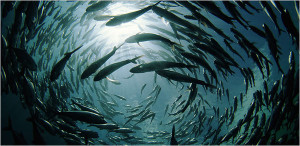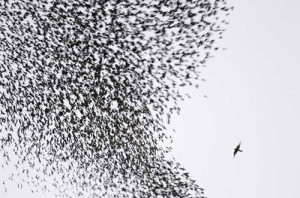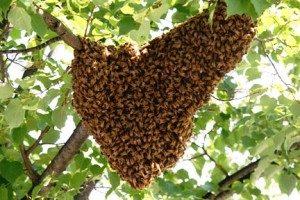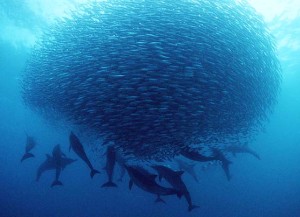What Animals Swarm and Why
Birds of a feather flock together. But why exactly? It’s not just birds-mammals, reptiles, amphibians, fish, insects and even bacteria all do it. Virtually every corner of the animal kingdom has found that banding together is a great tactic for surviving in the wild. As with everything else in nature, it boils down to two things: finding enough food and avoiding becoming food for something else. Swarming can help with both.
Herring, for example, feed on copepods. These tiny crustaceans, one or two millimeters (0.04-0.08 inches) long can shoot suddenly sideways for a couple of centimeters to evade an approaching fish. Herring aren’t agile enough swimmers to react to this jump, so instead they swim in large schools with the gap between fish synchronised to the jump distance of the copepod. This increases each fish’s chance of a meal because if a copepod leaps out of the path of one fish, it lands directly in front of another.
 At the other end of the food chain, another marine crustacean – the krill – swarms to avoid predation. A large swarm of randomly swirling krill makes it much harder for fish to pick out any single target.
At the other end of the food chain, another marine crustacean – the krill – swarms to avoid predation. A large swarm of randomly swirling krill makes it much harder for fish to pick out any single target.
Ironically, krill swarms are so huge that it has become viable for a much larger kind of animal- the baleen whales-to evolve the specialised apparatus for straining out several tons of krill in a single gulp. Ironically the very behaviour that protects them from small fish and penguins makes them vulnerable to the biggest creatures of them all.
 Swarming also helps because it increases the number of eyes and ears on the alert for danger. A herd of wildebeest or a flock of seagulls allows each member to borrow the senses of the other animals as a sort of long-range radar.
Swarming also helps because it increases the number of eyes and ears on the alert for danger. A herd of wildebeest or a flock of seagulls allows each member to borrow the senses of the other animals as a sort of long-range radar.
There’s no need for direct communication; simply keeping up with the rest of their neighbours means that when one end of the group spots danger, the whole swarm wheels away from the threat as if it were a single organism. In fact, it’s possible that multicellular life itself began as nothing more than swarming behaviour.
Dictyostelid amoebae (a form of slime mould) live the ordinary, solitary life of a single-celled organism when food is abundant. But when it runs out, they secrete a chemical signal called cyclic adenosine monophosphate (cAMP) that attracts other nearby Dictyostelids. At a certain critical mass, the amoebae form into a multicellular ‘slug’ up to four millimetres (0.16 inches) long and move off in search of new food. The slug has a definite front and back end and moves towards heat, light and humidity. It acts like a simple multicellular animal, but it’s actually just an amoeba swarm.
Swarms have a dark side too though. Because the swarm moves and acts as one, it can quickly become unstable. At low population densities, locusts move about randomly or in small groups. This is controlled by the level of serotonin in each locust, which increases in response to stress. As the density rises they become more and more co-ordinated until, at about 74 locusts per square metre, they stop changing direction altogether and march like an army for hours at a time. Locust swarms begin in response to overcrowding, but because they all travel together, they just make the overcrowding worse, sweeping across farmland like a wildfire and destroying all plant life in their path. It’s precisely the co-ordination and synchronization that can make the swarm so destructive.
Collective consciousness in focus
Each of your brain cells has no intelligence by itself. But connected together in sufficient numbers, they display remarkable new properties. In a similar way, a swarm of animals exhibits behaviours that go far beyond the reasoning abilities of individuals.
Honeybee swarms will invariably choose the best site for a new hive, even though each bee will have personally visited, at most, one of the potential sites and so can’t compare it with any others. Decisions are made by means of a positive feedback loop, with more of the returning bees ‘voting’ enthusiastically for the better sites through their special dance.
The way a swarm moves together as a coherent unit might seem like it involves a high degree of communication and leadership. But there is actually no centralized control. Ants, for instance, will follow a pheromone trail laid on the forest floor. But as they walk they also lay down a trail of their own. This makes the scent trail more powerful and the path becomes more popular. Like a stream cutting an ever-deeper valley as it flows downhill, the ant colony reinforces the popular routes and the swarm sticks together without any individual ant actually marshalling their movement.
Even the more complex animals such as birds form swarms on the basis of surprisingly simple rules. Starlings, for example, simply try to fly in the same direction as their closest six or seven neighbours. But the result is a swirling cloud of birds that appears to have a collective mind of its own.
The power of the swarm
 Not all swarms are destructive. A swarm of honeybees is essentially peaceful, unless the queen is threatened. And krill drift in the open ocean so the most they can do is eata lot of plankton.
Not all swarms are destructive. A swarm of honeybees is essentially peaceful, unless the queen is threatened. And krill drift in the open ocean so the most they can do is eata lot of plankton.
However swarms feeding on land can quickly strip an area bare, simply by virtue of their population density. Locust swarms, for example, can reach into the billions – with some 380 million insects per square kilometer. Resembling a uniform blanket of locusts, there’s no amount of vegetation that can withstand that many mouths for long.
Even when overfeeding isn’t a problem, swarms can still cause enormous damage. An animal that might be perfectly innocuous by itself can cause a lot of trouble in large enough numbers. Large flocks of starlings can leave a carpet of droppings up to 30 centimeters (11.8 inches) deep under the trees where they roost. The ammonia compounds in their droppings can quickly reach toxic levels, poisoning grass and other plants if the flock doesn’t move on within a few days.
What Animals Swarm
Bee swarm – Honeybees swarm when the colony grows too big for its current hive. The queen and up to 60 per cent of the worker bees leave the hive and settle on a tree branch a few metres away. Other workers scout out possible new nest sites over the course of a few days and then the swarm flies together to establish a new colony.
Locust swarm – Locusts are the final adult stage of certain grasshopper species. In crowded conditions, the grasshoppers will change into a ravenous, fast-breeding form. The population quickly explodes into swarms of billions and each locust will eat its own body weight in plant matter every day. Large locust swarms can cover an area the size of Greater London.
 Starling swarm – Starlings are highly social birds and will often congregate in large flocks of up to a million. This reduces the risk of predation from birds of prey as they move between roosting sites and feeding grounds, because the swirling mass is hard to target. Flocks often contain individuals from different species of starling.
Starling swarm – Starlings are highly social birds and will often congregate in large flocks of up to a million. This reduces the risk of predation from birds of prey as they move between roosting sites and feeding grounds, because the swirling mass is hard to target. Flocks often contain individuals from different species of starling.
Sardine swarm – Every year, young sardines swim from the tip of South Africa, where they spawned, up the coast of Mozambique and into the Indian Ocean. It is thought that cold-water currents trigger this migration. The school can cover an area of 7.1 x 1.5 kilometres (4.4 x 0.9 miles) and 30 metres (98 feet) deep, containing billions of sardines. Up to 18,000 dolphins tag along to feed.
Krill swarm – Krill are a shrimp-like crustacean. Antarctic krill have a total biomass twice that of all the humans in the world. Half of this is eaten every year and, to protect themselves, they band together in huge shoals that drift up and down in the water column every day.
Wildebeest swarm – Wildebeest migrate annually across the Serengeti to follow the rainfall and most nutritious grass. Herds of 1.4 million travel 2,900 kilometres (1,800 miles) per year in a clockwise circle around eastern Africa. Wildebeest are powerful and aggressive, but they still need the additional security of the herd to protect them from hyenas and lions.
Swarming humans
Humans can swarm too. When large crowds gather, the limited communication between people causes them to fall back on simple rules: keep moving in the same direction as everyone else; try not to get too squashed up; don’t get left behind. If there’s a bottleneck or something triggers a panic, the crowd can suddenly become dangerous. In 2005, almost a thousand people died during a stampede in Iraq, when pilgrims marching to the Al-Kadhimiya Mosque in Baghdad became panicked by fears of a suicide bomber.
But the science of swarming can also be useful to humans. The simplicity of the rules that control a swarm makes them ideal for robots and simulations. Airports use swarming behaviours adapted from ant colonies to model the flow of passengers through the terminal and to determine the best departure gate to assign to each flight.
Elsewhere hovering drones the size of your hand have already been successfully programmed to fly in formation and navigate around obstacles without a human to steer them. In the future, these could be used for military reconnaissance as well as search and rescue missions.

